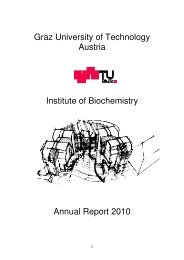Staff Members of the Institute of Biochemistry, TU - Institut für ...
Staff Members of the Institute of Biochemistry, TU - Institut für ...
Staff Members of the Institute of Biochemistry, TU - Institut für ...
Create successful ePaper yourself
Turn your PDF publications into a flip-book with our unique Google optimized e-Paper software.
Diploma Thesis completed<br />
Sabine Zitzenbacher: Characterization <strong>of</strong> organelles from <strong>the</strong> yeast Pichia pastoris<br />
Characterizations <strong>of</strong> cell organelles from organisms start with a successful isolation <strong>of</strong> <strong>the</strong><br />
organelle <strong>of</strong> interest. Isolation protocols are available, but <strong>the</strong>y usually have to be optimized.<br />
A problem <strong>of</strong> each organelle preparation is cross-contamination with o<strong>the</strong>r cellular organelles<br />
in <strong>the</strong> isolated organelle fraction. Here we tested <strong>the</strong> quality <strong>of</strong> preparation protocols for<br />
mitochondria and microsomes, plasma membrane and vacuoles, used for <strong>the</strong> strain Pichia<br />
pastoris. Isolated fractions were analysed by Western blot analysis and functional enzyme<br />
assays. Results <strong>of</strong> isolated mitochondrial and microsomal fractions showed a clear enrichment<br />
<strong>of</strong> mitochondria as well as microsomes. In <strong>the</strong> mitochondrial fraction a minor ER<br />
contamination was observed, whereas <strong>the</strong> microsomes fractions were free from crosscontamination.<br />
Analysis <strong>of</strong> <strong>the</strong> isolated plasma membrane fraction showed enrichment <strong>of</strong><br />
plasma membrane without any cross contamination with o<strong>the</strong>r organelles. Both preparation<br />
protocols have proven to be well established for Pichia pastoris. The last protocol<br />
investigated showed an enrichment <strong>of</strong> vacuoles in <strong>the</strong> isolated fraction, but <strong>the</strong> vacuolar<br />
fraction also showed a high contamination with mitochondria. Thus, <strong>the</strong> protocol has to be<br />
modified to get an isolated vacuolar fraction without any or with only little crosscontamination.<br />
In <strong>the</strong> past, different cell organelles, such as peroxisomes, mitochondria,<br />
microsomes and plasma membrane from Pichia pastoris were characterized. The missing<br />
organelle is <strong>the</strong> Golgi apparatus. Here we established an isolation protocol for Golgi isolation<br />
from Pichia pastoris. The obtained Golgi fraction was analysed by Western Blot and<br />
enzymatic assays. Applying this new preparation protocol we showed an enrichment <strong>of</strong> Golgi<br />
in <strong>the</strong> isolated fraction largely free <strong>of</strong> cross-contamination with ER.<br />
Doctoral Thesis completed<br />
Tibor Czabany: Cell biology <strong>of</strong> neutral lipid syn<strong>the</strong>sis in yeast Saccharomyces cerevisiae<br />
Previously, four acyltransferases involved in <strong>the</strong> syn<strong>the</strong>sis <strong>of</strong> neutral lipids (NL),<br />
triacylglycerols (TAG) and steryl esters (SE), have been identified. Dga1p and Lro1p esterify<br />
DAG to produce TAG, and Are1p and Are2p are responsible for SE syn<strong>the</strong>sis. After <strong>the</strong> NL<br />
have been syn<strong>the</strong>sized <strong>the</strong>y are assembled in specialized organelles called lipid particles (LP).<br />
The hydrophobic core <strong>of</strong> LP containing TAG and SE is separated from <strong>the</strong> hydrophilic<br />
cytosol by a phospholipid monolayer. The present study is focused on elucidation <strong>of</strong> <strong>the</strong><br />
detailed structure using a set <strong>of</strong> triple mutants (TM) which contain only one <strong>of</strong> <strong>the</strong> four<br />
acyltransferases active. Using <strong>the</strong>se mutants we were able to investigate <strong>the</strong> influence <strong>of</strong><br />
individual enzymes on LP composition and structure. It was demonstrated that <strong>the</strong> four<br />
acyltransferases act independently <strong>of</strong> each o<strong>the</strong>r and are able to syn<strong>the</strong>size individually a<br />
sufficient amount <strong>of</strong> neutral lipids for LP biogenesis. Fur<strong>the</strong>rmore, TM and <strong>the</strong> quadruple<br />
mutant, lacking all four acyltransferases, were also used for studies <strong>of</strong> NL syn<strong>the</strong>sis when<br />
fatty acids were supplied as <strong>the</strong> only carbon source. Under <strong>the</strong>se conditions, fatty acids enter<br />
<strong>the</strong> cell and accumulate at high amounts which leads to disturbed lipid homeostasis. Changes<br />
in lipid metabolism caused by <strong>the</strong> lack <strong>of</strong> individual acyltransferase are described, especially<br />
<strong>the</strong> influence <strong>of</strong> excess fatty acids on neutral lipid syn<strong>the</strong>sis. It was shown that yeast cells<br />
grown on oleic acid upregulated TAG syn<strong>the</strong>sis and down regulated esterification <strong>of</strong> sterols.<br />
Detailed analysis <strong>of</strong> SE synthase revealed that <strong>the</strong> down regulation <strong>of</strong> this activity was not by<br />
transcriptional control but ra<strong>the</strong>r by direct inhibition <strong>of</strong> <strong>the</strong> enzyme in its membrane<br />
21














